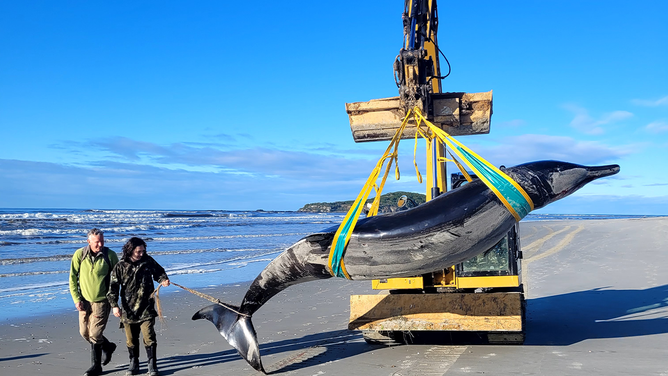
A rare discovery was made on the shores of New Zealand in July 2024, as a spade-toothed whale washed up near Taieri Mouth in South Island. This species, which is one of the most poorly known large mammalian species of modern times, has only been documented six times since the 1800s. The latest discovery could provide valuable insights into this elusive creature.
The Department of Conservation (DOC) was alerted to the find on July 4 and sent experts to inspect the carcass. Preliminary analysis suggests that it is indeed a spade-toothed whale, making it a significant discovery for scientists who have never before had the opportunity to study one in its entirety.
Spade-toothed whales are known for their distinctive features, including their long beak and two large tusks. They were first discovered in New Zealand in 1874 when a lower jaw and two teeth were found on Pitt Island. Since then, only a few skeletal remains and teeth have been documented elsewhere, most notably in Chile.
The discovery of the spade-toothed whale on the New Zealand shore has generated excitement among marine scientists who are eager to learn more about this rare species. Genetic samples have been sent to the University of Auckland for processing and confirmation of species identification. Once confirmed, scientists will be interested in studying details of the stomach and gastrointestinal tract to learn about its diet.
The Department of Conservation is working with local Maori communities, including Te Runanga o Otakou, to decide on next steps for the whale. If it is indeed a spade-toothed whale, this will mark the first time scientists can dissect one and learn more about its biology and behavior.
The discovery of the spade-toothed whale in New Zealand is significant from both a scientific and conservation perspective. With only six documented cases worldwide, there is much to be learned about this elusive creature. The opportunity to study a complete specimen could provide valuable insights into its biology and behavior, as well as its role in the marine ecosystem.


:max_bytes(150000):strip_icc():focal(941x526:943x528)/spade-toothed-whale-071524-tout-6a2f7ec1357e4be68757ffc70a6f6d39.jpg)

